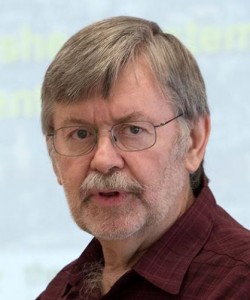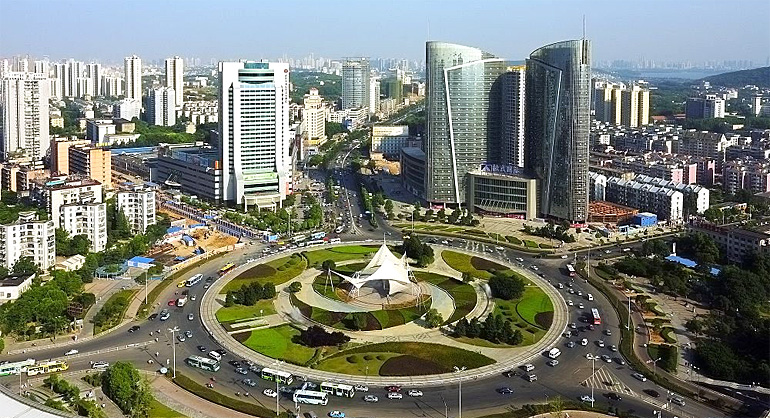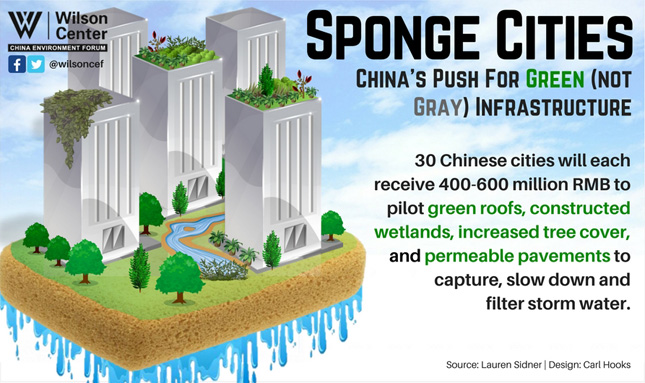“Sponge Cities” – a catchy way to describe the goal in restoring the capacity of the urban landscape to absorb water and release it naturally
Note to Reader:
 Recent water-centric developments in China and Berlin have caught the attention of the world.
Recent water-centric developments in China and Berlin have caught the attention of the world.
Consider that, in 2013, President Xi Jinping injected a new term into the global urban design vocabulary when he proclaimed that cities should “act like sponges” and launched China’s Sponge City program.
And then in August 2017, the Senate of Berlin released its Sponge City Strategy. The common guiding philosophy for both? Mimic nature, restore the water balance, adapt to a changing climate.
Revisiting our relationship with nature is necessary because…
The warming of the planet’s atmosphere is causing water to move more quickly and disruptively through the global water cycle. Flood, drought, fire, wind and cold – extreme events are becoming the norm. Instabilities in the water cycle are increasingly apparent.
 “All one need do is reflect on what British Columbia has experienced in 2015, 2016 and 2017. Impacts are magnified by human interventions. We have arrived at a fork in the road,” states Kim Stephens, Executive Director, Partnership for Water Sustainability in British Columbia.
“All one need do is reflect on what British Columbia has experienced in 2015, 2016 and 2017. Impacts are magnified by human interventions. We have arrived at a fork in the road,” states Kim Stephens, Executive Director, Partnership for Water Sustainability in British Columbia.
“The situation calls for a whole-systems approach to managing the water balance distribution where people live. The risks are too high, and the margins for error too small, to view water and watersheds only through narrow technical lenses. Adapting to changes in the water cycle and restoring the water balance starts with re-visiting our relationship with nature.
“Initiatives in China and Berlin provide reason for optimism. Also, it is reassuring that they too are on a journey where the destination is a water resilient future. The ‘sponge city’ imagery resonates. People intuitively get it. The global context provided by these initiatives means that we, the Partnership for Water Sustainability, have a timely backdrop for our educational efforts in British Columbia.”
Whole-System, Water Balance Approach
“The need to protect headwater streams and groundwater resources in British Columbia requires that communities expand their view – from one that looks at a site in isolation – to one that considers HOW all sites, the watershed landscape, streams and foreshores, groundwater aquifers, and PEOPLE function as a whole system,” continues Kim Stephens.
“Inter-governmental collaboration and funding enable the Partnership to develop approaches, tools and resources; as well as provide teaching, training and mentoring.
“Our educational goal is to build practitioner capacity within the local government setting to implement a whole-system, water balance approach branded as Sustainable Watershed Systems, through Asset Management.“
And be sure to apply tools and resources!
“The ‘sponge city’ metaphor is powerful and inspirational. As such, China and Berlin are demonstrating that when there is a will, there is a way.
“Still, we urge the reader to take a moment to reflect upon their drivers for action – floods and droughts! They have learned the hard way that what happens on the land matters.
“And now, the ‘new normal’ of frequently recurring extremes has forced them to tackle the consequences of not respecting the water cycle.”

Wuhan, population 10 million, is one of the first of 16 cities in China to launch project Sponge City – a flexible solution for both water-scarce and water-logged cities.
THE CHALLENGE:
“Opportunities for land use and infrastructure servicing practitioners to make a difference are at the time of (re)development. To those folks we say: share and learn from those who are leading change; design with nature; ‘get it right’ at the front-end of the project; build-in ‘water resilience’; create a lasting legacy,” urges Kim Stephens.
“Many land and infrastructure professionals in this province do know in principle what they ought to do. However, there is still a gap between UNDERSTANDING and IMPLEMENTATION. This results in a capacity-building challenge: on the one hand, we can provide practitioners with water balance tools and resources; it is another matter for those folks to apply the tools and resources.”
MISSION POSSIBLE:
“Yes, British Columbia is progressing. Yet communities could do so much more if they would capitalize on rather than miss opportunities. Apply the tools. Do what is right. Learn from experience. Adapt. Pass the baton.
“The Partnership spotlight is on how to ‘bridge the gap’ between talk and action. As champions for the Whole-System, Water Balance Approach, we are developing tools and resources for use by local governments.”

The physics are straightforward: 7% additional water volume for each degree of temperature rise. This is the global part. If communities are serious about ensuring RESILIENCY, then the critical strategies and actions are those that relate to water.


